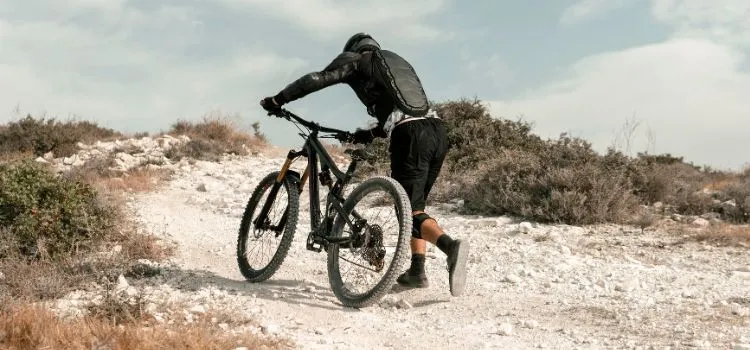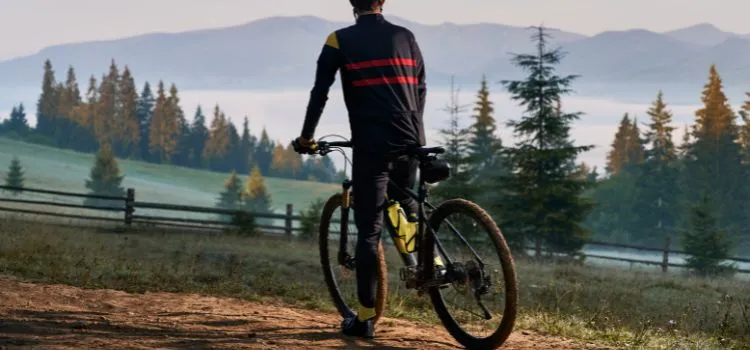How To Know If Your Mountain Bike Is Too Big In Size

Choosing the proper size is perhaps the most crucial step whether you’re seeking to get an entirely novel mountain bike or upgrade your current model. It would be best if you had a bike that is safe to ride, responsive, and comfortable to ride. How do you know if the size of your bike is genuinely too large?
Table of Contents
Short Answer
You might be curious to know what are the Signs Your Mountain Bike Is Too Big. If maneuvering your bike is difficult, you have difficulty or any kind of discomfort each time you ride, or you have trouble performing simple feats while getting your mountain bike in the air, your bike may be too big. Furthermore, your bike is unquestionably too giant if you lean over it and your feet can’t touch the ground.
Let’s examine how to determine if your giant mountain bike is the cause of any of these problems in the event that you experience any of them. Also, examine some situations in which you may want to pick a large-sized mountain bike.
7 Major Signs Your Mountain Bike Is Too Big.
The following seven indicators suggest that your mountain bike could be too large for you:
- Difficulty grabbing the bike handlebars:
If the amount of distance between the seat and the bike handlebars is too significant, you can have trouble comfortably grabbing the handlebars. This may result in shaky maneuvering and an overall lack of riding confidence.
- Having trouble standing over the bike:
If you need to stretch out or balance your tiptoes in order to straddle the bike, the frame might be too big for you. Due to this, dismounting may be challenging, and the chance of harm from a fall may also increase.
- An excessively long top tube:
The top tube, which joins the seat and handlebars to the frame, should be short. If the top tube is excessively lengthy, you might stretch out too much, which would be uncomfortable and would be challenging to regulate.
- Difficulty cornering:
The bike may be too big for you if you find it challenging to lean the bike into turns, especially at faster speeds. When biking on rugged trails, this can be especially risky.
- Unsteadiness
The handlebars may be too far away, or the frame may be too tall if you have the feeling you are continuously working to keep your balance while riding the bike. This may make it more challenging to ride with assurance and raise the possibility of collisions.
- An excess of weight on the front wheel:
When you notice that you are leaning too far forward while riding, it may be because the handlebars are too far away or the frame is lengthy. The front wheel may be overloaded. As a result, making it is challenging to manage the bike.
- Pain or discomfort:
If you feel pain or discomfort while riding in your neck, shoulders, back, or knees, it may be because the bike is too big for you. This may reduce the fun of riding and eventually result in damage.
It is crucial to keep in mind that some of these symptoms could also point to other problems with the way your bike is set up, including an incorrect seat height or handlebar placement. To make perfectly sure that your bike is adequately sized and set for your body, it’s a good idea to speak with a fitting bike expert or your neighborhood bike shop if you’re having any of these problems.
Potential Dangers Of Riding A Bigger Mountain Bike:

A mountain bike that happens to be too large for you can put you in danger of a number of things. Some of the significant highlighted points which you should always keep in mind are given as follows:
- Lack of control:
You might find it challenging to control the bike if you can’t properly reach the bike handlebars or if you have trouble leaning into curves. This may result in an impairment of control as well as handling and a higher chance of collisions.
- Higher risk of injuries.
If you find it difficult to remain over the bike or get off, you may be more likely to trip and hurt yourself. This risk is very significant when traveling at a faster pace or on technical terrain.
- Poor riding style:
When you are riding a bike that seems to be too large for you, you could adopt a poor riding style to make up for the uncomfortable fit. This makes it more difficult to advance as a rider and might result in undesirable habits that are hard to change.
- Bodily strain:
Riding a mountain bike that is too large might strain your neck, shoulders, and back in particular. If this is left unattended, it may cause discomfort, agony, and possibly long-term harm.
- Lessened self-assurance:
Whenever riding a mountain bike that does not fit comfortably and adequately may make you feel less self-assured and less willing to take on rugged terrain or challenges. This may hinder your riding development and lessen your enthusiasm for the game.
- Frustration and unhappiness:
If you purchase a mountain bike that is too large for you, you might discover that it falls short of your expectations or doesn’t deliver the performance you were looking for. This could make you frustrated and unsatisfied with the athletic activity, and it might even make you want to stop riding.
All in all, riding a mountain bike that is too large for you can result in a variety of risks and unfavorable consequences. To ride securely, comfortably, and confidently, you must make sure that your bike suits effectively and is suited to your body.
Reasons Why People Might Prefer Bigger Bikes:

There are various causes for wanting a giant mountain bike, including the following:
- Fitting:
For a bike rider who is a bit taller or seems to have a long inseam, a larger mountain bike might be more comfortable. In order to provide a more convenient and efficient bike riding posture, which can improve performance and lower the risk of injury, a bike should be the correct size.
- Steadiness:
A bigger bike might offer better balance and stability, especially when traveling at high speeds or on challenging terrain. Bike riders who constantly challenge their limits while taking on more difficult trails may find this to be particularly beneficial.
- Control and handling:
A bigger mountain bike might provide you with more leverage, which makes it simpler to steer the bike across rugged terrain. When navigating tricky features or steep descents, this can be very crucial.
- Confidence:
Riding a larger bike can boost one’s confidence, especially when navigating rugged terrain. This can be highly crucial for bike riders who are newbies to this sport or want to challenge themselves.
Which Is Better To Have, A Bigger Or Smaller Mountain Bike?
The actual size of a mountain bike’s frame significantly impacts the rider’s comfort and efficiency. In general, it is preferable to have a mountain bike frame that fits your body well.
A frame that is very small can make you feel constrained and uneasy when riding, as well as perhaps make you unsteady. On the other extreme, a bike frame that is too big might be challenging to manage and can make you feel stretched out and uneasy, which could result in back pain and other problems.
Always consider your total height and inseam length. And riding style to choose the correct frame size for you. To achieve a custom fit, you can go to a bike shop or refer to the manufacturer’s given sizing guide. You can take advantage of your time on the biking trails by riding a mountain bike with a frame that has been properly fitted.
How Do I Know When My Bike Is Small In Size?
You might feel uncomfortable and have performance concerns if the mountain bike is too small. You may be riding a mountain bike that is very small for you if these symptoms apply:
- You experience a tight fit on the bike:
Your mountain bike may be too small for you if you feel cramped while riding it or if your knees or elbows frequently collide with the handlebars or top tube.
- You have lower back discomfort:
Lower body pain in the back while riding may indicate that the bike is very small for you and that you are hunching over excessively.
- You feel unsteady:
If you feel unsteady on the bike, especially when traveling downhill or over uneven terrain, it may be because the bike is too small for you and you lack balance.
- You get knee pain when riding:
If your knees hurt while you’re riding, it may be because the bike is too tiny and your knees are having to bend too much.
It is essential to think about whether your mountain bike is the appropriate size for you if you are having any of these problems. To make sure you are riding a mountain bike that is the right size for your physique, you may wish to refer to a sizing chart given by the bike maker or visit a local bike shop to have a professional fitting.
How Can You Determine If A Mountain Bike Is The Right Size?
Start by looking up the recommended frame size from the manufacturers. As you approach the handlebars, consider whether you feel too stretched or confined. Essentially, you want to experience neutral feelings when riding the bike. If you want to learn more about frame sizing, continue reading this article.
Conclusion:
Now you know what are the signs your mountain bike is too big. It is always important to remember that there are other considerations to make when picking a bike in addition to the mountain bike’s size. Additional elements, including the frame material, suspension design, and wheel size, can significantly influence the performance and appropriateness of the bike for various riding styles. All in all, the size of the bike totally depends upon your body dimensions and personal body requirements.
